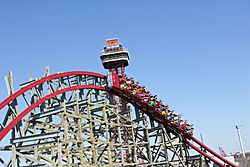New Texas Giant facts for kids
Quick facts for kids New Texas Giant |
|
|---|---|
| Previously known as Texas Giant | |
 |
|

New Texas Giant features steel track and overbanked turns
|
|
| Six Flags Over Texas | |
| Location | Six Flags Over Texas |
| Park section | Texas |
| Coordinates | 32°45′23″N 97°4′23″W / 32.75639°N 97.07306°W |
| Status | Operating |
| Opening date | April 22, 2011 |
| Cost | US$10 million |
| Replaced | Texas Giant |
| General statistics | |
| Type | Steel |
| Manufacturer | Rocky Mountain Construction |
| Designer | Alan Schilke |
| Model | I-Box – Custom |
| Lift/launch system | Chain lift hill |
| Height | 153 ft (47 m) |
| Drop | 147 ft (45 m) |
| Length | 4,200 ft (1,300 m) |
| Speed | 65 mph (105 km/h) |
| Inversions | 0 |
| Duration | 3:25 |
| Max vertical angle | 79° |
| Capacity | 1600 riders per hour |
| G-force | 4.2 |
| Height restriction | 48 in (122 cm) |
| Trains | 3 trains with 6 cars. Riders are arranged 2 across in 2 rows for a total of 24 riders per train. |
| New Texas Giant at RCDB | |
The New Texas Giant is an exciting steel roller coaster at Six Flags Over Texas in Arlington, Texas. It used to be called the Texas Giant and was made of wood. This ride is famous for its big drops and thrilling turns. It's a favorite for many people who love roller coasters!
The original Texas Giant opened in 1990. It was a very popular wooden coaster for many years. But over time, it became a bit rough to ride. So, in 2009, the park decided to give it a huge makeover.
After 18 months of work, the ride reopened in 2011 as the New Texas Giant. They kept most of the original wooden frame. But they replaced the old wooden track with a new, smooth steel track. This made the ride taller, faster, and much more exciting! It even won an award for being the "Best New Ride."
In 2013, there was a sad accident on the ride. After this, the park made important changes to the ride's safety system. These changes included new seat belts and pads to keep riders even safer.
History of the Texas Giant
Building the Original Wooden Coaster
In September 1989, Six Flags announced plans for two new wooden roller coasters. One was for Six Flags Over Texas, called The Texas Giant. The other was for Six Flags Over Georgia.
The Texas Giant was built using a lot of wood. It used over 900,000 board feet of timber. The ride's trains were made by a company called Philadelphia Toboggan Coasters. The Texas Giant officially opened on March 17, 1990. When it first opened, it was the tallest wooden roller coaster in the world. It stood 143 feet (44 meters) high.
Why the Ride Needed a Change
Over the years, the Texas Giant had some updates. Parts of the track were changed. The trains were also made shorter, from seven cars to six cars. Park workers also did a lot of maintenance on the wooden track.
In 2008 and 2009, Six Flags Over Texas worked on over 1,200 feet (370 meters) of track. They wanted to make the ride smoother. Even with these repairs, the park needed a better, longer-lasting solution. People thought the ride might be removed, but Six Flags said that wasn't true.
The Big Renovation Begins
In March 2009, the park announced that the Texas Giant would close for a $10 million renovation. The ride closed on November 1, 2009, after the park's Fright Fest event.
Work started right away. All of the old wooden track was removed. Some of the wooden support structure was also changed. On March 3, 2010, Six Flags Over Texas showed off the new steel track. This new track was called I-Box track. It was made by a company called Rocky Mountain Construction (RMC).
How the New Track Was Made
The I-Box steel track was developed over three years. It was designed to replace wooden tracks. The new steel track looked similar to the old wooden rails. It also had about the same weight and size.
Engineers designed changes to the ride's path. The steel track pieces were made in Idaho. They were machine-welded from flat steel plates. This created the 3D track parts.
Exciting New Features
The renovation changed much of the ride's layout. The lift hill was made 10 feet (3.0 meters) taller. The first drop became much steeper, at 79 degrees. Several "overbanked turns" were added. These turns tilt riders up to 115 degrees!
The renovated ride was named the New Texas Giant. It reopened on April 4, 2011.
Ride Features and Design
Where is the New Texas Giant?
As its name suggests, the New Texas Giant is located in the Texas section of Six Flags Over Texas. It was the very first roller coaster to use Rocky Mountain Construction's special I-Box track.
The Ride's Trains
The New Texas Giant uses three trains. These trains were made by a company called Gerstlauer. The trains are colored red, blue, and black. They are designed to look like 1961 Cadillac Deville cars.
Each train has six cars. Each car seats two riders in two rows. Riders are held safely in place by a hydraulic lap bar and a seat belt.
Comparing Old and New
The original Texas Giant was 10 feet (3.0 meters) shorter than the New Texas Giant. The renovated New Texas Giant has a steeper and longer first drop. This means it also reaches a faster top speed.
The old ride had a 540-degree helix (a big spiral turn) after the middle brake section. This was changed to a 180-degree turnaround. This made the track length about 400 feet (120 meters) shorter.
| Statistic | Texas Giant | New Texas Giant |
|---|---|---|
| Years | 1990–2009 | 2011–present |
| Manufacturer | Dinn Corporation | Rocky Mountain Construction |
| Designer | Curtis D. Summers | Alan Schilke |
| Track | Wood | Steel |
| Height | 143 ft (44 m) | 153 ft (47 m) |
| Drop | 137 ft (42 m) | 147 ft (45 m) |
| Length | 4,920 ft (1,500 m) | 4,200 ft (1,300 m) |
| Speed | 62 mph (100 km/h) | 65 mph (105 km/h) |
| Max vertical angle | 53° | 79° |
| Trains | Philadelphia Toboggan Coasters (PTC) | Gerstlauer |
What's the Ride Like?
The New Texas Giant ride begins with a right turn out of the station. This leads right to the 153-foot (47-meter) tall chain lift hill. As you reach the top, get ready!
Once at the top, riders drop 147 feet (45 meters) at a very steep angle of 79 degrees. After this big drop, you go through a "double up." This is a small hill followed by another small hill.
Next, the train goes into a 90-degree overbanked turn. Then there's a dip and another overbanked turn, this one 95 degrees. Another dip and rise lead into an even bigger 115-degree overbanked turn.
After exiting this turn, you hit a small air-time hill. This hill gives you the most "negative g-force" on the ride. This means you feel a floating sensation! Then, the train goes up into the mid-course brake run.
From the brake run, the train drops again. It then goes through a series of low-to-the-ground air-time hills. These hills give you more floating feelings! The ride also has exciting directional changes. It speeds through three separate tunnels. Finally, it reaches the last brake run and a short path back to the station.
Images for kids





